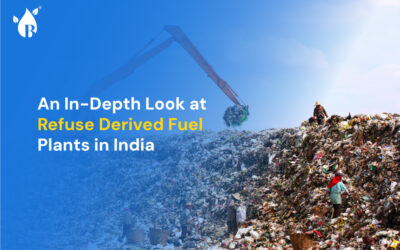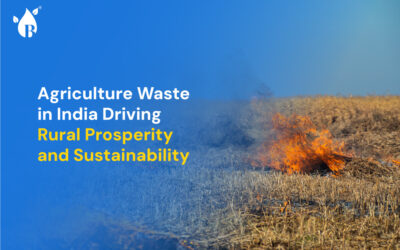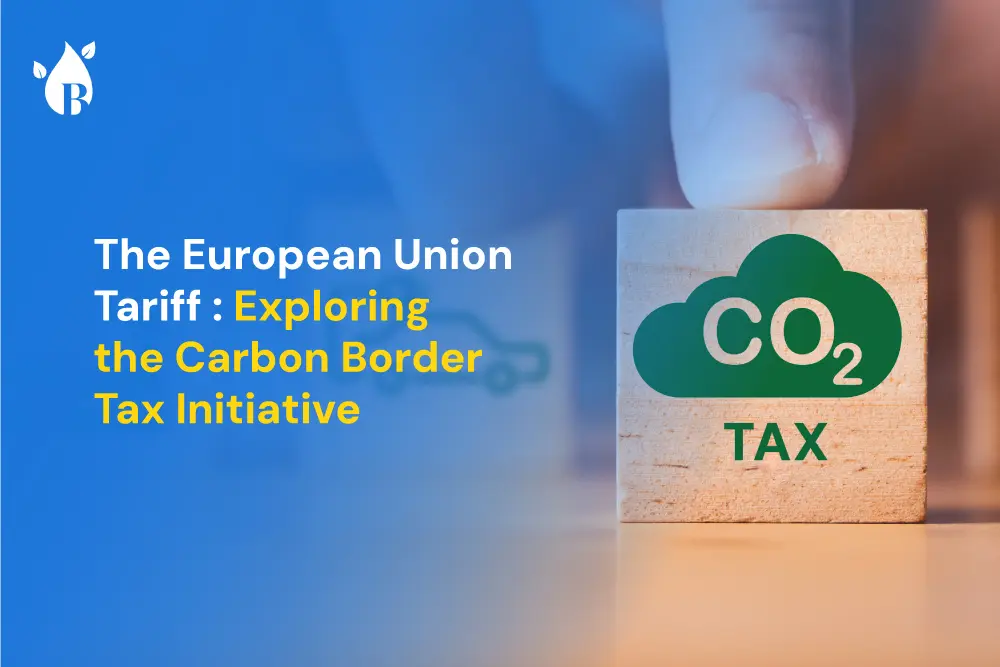
The Carbon Border Adjustment Mechanism (CBAM) stands as the EU’s strategic response to carbon emissions. But what exactly is it, how does it function, and what implications does it hold for India? Let’s delve into the intricacies of this mechanism to understand its workings and its impact on India.
The European Union has been vocal about carbon emissions for quite a long time. However, until recently, there was no specific mechanism in place to address this issue. In a significant stride towards climate action, the 27-member European Union (EU) has been intensifying its efforts.
The European Parliament, the legislative body of the EU, has been actively engaged in climate negotiations and has recently approved a comprehensive agreement to reform the EU’s carbon market. This deal aims to reduce emissions by 62% from 2005 levels by 2030 and introduces the Carbon Border Adjustment Mechanism (CBAM). The CBAM is designed to create a level playing field for both EU and non-EU manufacturers, while also encouraging trading partners to adopt carbon pricing as a vital tool in the fight against climate change. In this blog, we will delve into what these developments truly mean, how it works and how they can impact India.
What is Carbon Border Adjustment Mechanism (CBAM)?
The Carbon Border Adjustment Mechanism (CBAM) is a crucial tool introduced by the EU to effectively address carbon emissions from carbon-intensive goods imported into the EU. Its primary goal is to establish a fair price for the carbon emitted during the production of these goods and promote cleaner industrial practices in non-EU countries.
In line with the EU’s strategy to gradually eliminate the allocation of free allowances under the EU Emissions Trading System (ETS) and facilitate the transition to a low-carbon industry, the CBAM will also be gradually implemented.
By ensuring that a payment is made for the carbon emissions embedded in imported goods, the CBAM will guarantee that the carbon price of imports reflects that of domestic production. This way, the EU can protect its climate objectives and avoid undermining its efforts to combat climate change. Moreover, the CBAM has been specifically crafted to comply with WTO rules and regulations.
How does the CBAM Scheme work?
If the CBAM Scheme is implemented as intended, EU importers will be obliged to purchase carbon certificates equivalent to the carbon price that would have been paid if the goods had been produced domestically within the EU.
The price of these certificates will be determined based on the auction prices in the EU carbon credit market. The quantity of certificates needed will be determined annually, taking into account the volume of goods imported into the EU and the associated embedded emissions.
Initially, the CBAM Scheme will be applicable to imports of cement, iron and steel, aluminum, fertilizers, and electricity.
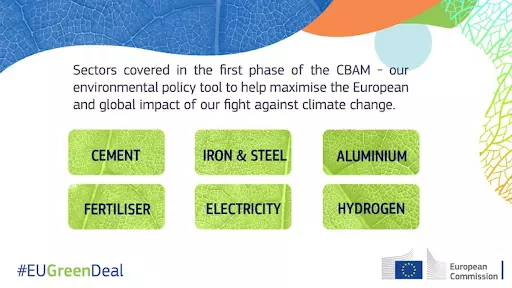
Source: European Union
The implementation of the CBAM Scheme is set to commence gradually from October 2023, subject to necessary approvals. Importers in the EU will firstly be required to gather data on the quantity of carbon dioxide released during the production of the imported goods.
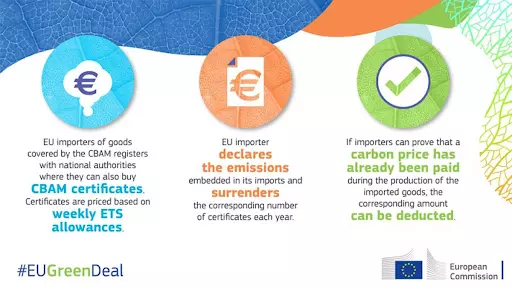
Source: European Union
Subsequently, importers will need to purchase a specific type of pollution certificate that reflects these emissions, at prices aligned with the EU’s Emissions Trading System. However, if a carbon tax has already been paid in the country where the goods were manufactured, the fee for the pollution certificate may be partially waived.
“If the CBAM Scheme is implemented as intended, EU importers will be obliged to purchase carbon certificates equivalent to the carbon price that would have been paid if the goods had been produced domestically within the EU.”
How can CBAM Impact India?
The implementation of the CBAM by the EU is expected to have significant economic implications for India. Specifically, Indian exports of energy-intensive products like steel, aluminum, cement, and fertilizers may face challenges such as higher prices, reduced competitiveness, and lower demand in the EU market.
The steel industry, which contributes nearly eight percent of global emissions, is considered a hard-to-abate sector. Carbon emissions from the iron and steel sector have been on the rise due to increased steel demand and the energy required for production, according to the International Energy Agency (IEA).
A recent report by the Global Trade Research Initiative (GTRI) highlights key concerns for India’s metal sector. In 2022, the EU accounted for 27 percent of India’s exports of iron, steel, and aluminum products worth US$8.2 billion.
However, starting from January 1, 2026, the EU will impose a carbon tax on each shipment of steel and aluminum, resulting in Indian firms paying additional charges equivalent to 20-35 percent of tariffs.
The impact of the CBAM on India will ultimately depend on the carbon intensity of the exported products and the availability of low-carbon substitutes in the EU market. Products with high carbon intensity are likely to face higher charges, diminishing their competitiveness. Nevertheless, if there are no low-carbon alternatives for Indian goods in the EU market, the effect of the CBAM on Indian exports might be minimal.
One of the major challenges India faces is the absence of an emissions trading system like the EU’s ETS. This may make it challenging for Indian businesses to demonstrate their use of low-carbon technology, resulting in higher charges under the CBAM.
How Can India Minimize the Influence of CBAM?
To maintain competitiveness globally and mitigate the impact of the CBAM, India should implement a carbon pricing mechanism, foster the development of low-carbon technologies, transition to cleaner production methods, and provide incentives for greener practices. These measures will assist Indian businesses in complying with CBAM regulations and reducing the carbon intensity of their products. Additionally, India should review its export strategy and identify alternative markets where its products can remain competitive despite the impact of the CBAM in the EU market.


